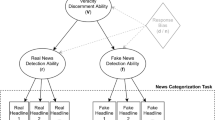Abstract.
This paper focuses on the problem of analyzing how factors impact hunger across states when hunger is ill-defined. Hunger (which is a latent variable) is presumed to depend on macroeconomic, legislation, policy, and demographic variables. Based on the Bayesian method of a posterior odds ratios, we find that the high school graduation rate appears to be the single most important factor we identify which affects the perceived hunger measure.
Similar content being viewed by others
Author information
Authors and Affiliations
Additional information
First version received: December 1996/final version received: September 1998
Rights and permissions
About this article
Cite this article
Ryu, H., Slottje, D. Analyzing perceived hunger across states in the US. Empirical Economics 24, 323–329 (1999). https://doi.org/10.1007/s001810050057
Issue Date:
DOI: https://doi.org/10.1007/s001810050057




